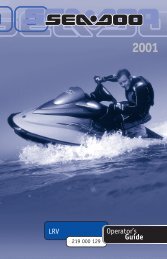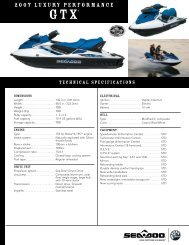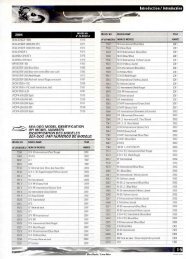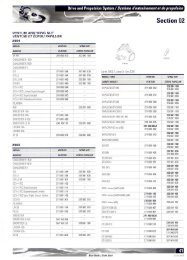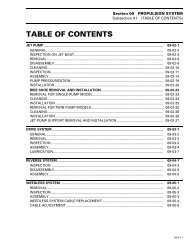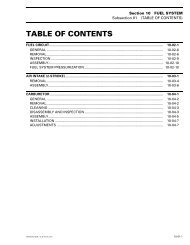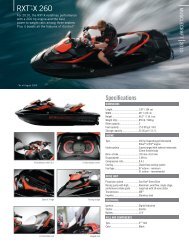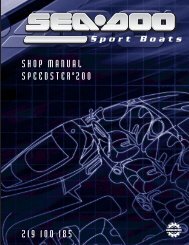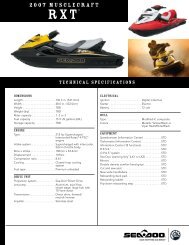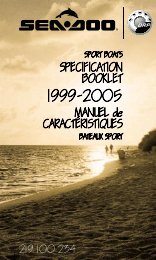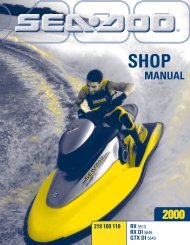warning - Sea-Doo.net
warning - Sea-Doo.net
warning - Sea-Doo.net
- No tags were found...
Create successful ePaper yourself
Turn your PDF publications into a flip-book with our unique Google optimized e-Paper software.
OPERATIONCollision AvoidanceDo not release throttle when trying tosteer away from objects. You needthrottle to steer.Always keep a constant lookout forother water users, other boats or objects,especially when turning. Bealert for conditions that may limit yourvisibility or block your vision of others.Respect the rights of other recreationistsand/or bystanders and alwayskeep a safe distance from all othercraft, people and objects.Do not wake or wave jump, ride thesurf line or attempt to spray or splashothers with your watercraft. You maymisjudge the ability of the watercraftor your own riding skills and strike aboat or person.This watercraft has the capability ofturning more sharply than other boats,however, unless in an emergency, donot negotiate sharp, high speed turns.Such maneuvers make it hard for othersto avoid you or understand whereyou are going. Also, you and/or yourpassenger(s) could be thrown fromthe watercraft.Like any other craft, this PWC has nobrake. Stopping distance will vary dependingon initial speed, load, wind,and water conditions. Practice stoppingand docking in a safe, traffic freearea to have an idea of how long it willtake to stop the watercraft under varyingconditions.Maintaining or increasing speed maybe necessary to avoid a collision.Safe RidingAlways keep in mind that as the throttlelever is released to idle position,less directional control is available, andas the engine is off, directional controlis lost. You need throttle to steer.Ride within your limits and level ofriding ability. Avoid aggressive maneuversto reduce the risk of loss ofcontrol, ejection and collision. Understandand respect the performance oryour watercraft.Always ride responsibly and safely.Use common sense and courtesy.While your watercraft has the capacityof operating at high speeds, itis strongly recommended that highspeed operation only be applied whenideal conditions exist and are permitted.Higher speed operation requiresa higher degree of skill and increasesthe risk of severe injuries.The forces generated on the bodyof riders while turning, negotiatingwaves or wakes, operating in choppywaters, or falling off the watercraft,especially at higher speeds, maycause injury including the possibility ofbroken legs and other bones or moreserious injuries. Remain flexible andavoid sharp turns.In shallow water, proceed with cautionand at very low speeds. Groundingor abrupt stops may result in injury.Debrismayalsobepickedupandbethrown rearward by the jet pump ontopeople or property.Do not use the watercraft’s reverse, ifso equipped, to stop. You or your passenger(s)could be violently ejectedforward onto the handlebars or evenoff the watercraft onto the hazard.PWCs are not designed for night-timeoperation.14 ___________ SAFETY INFORMATION ___________



